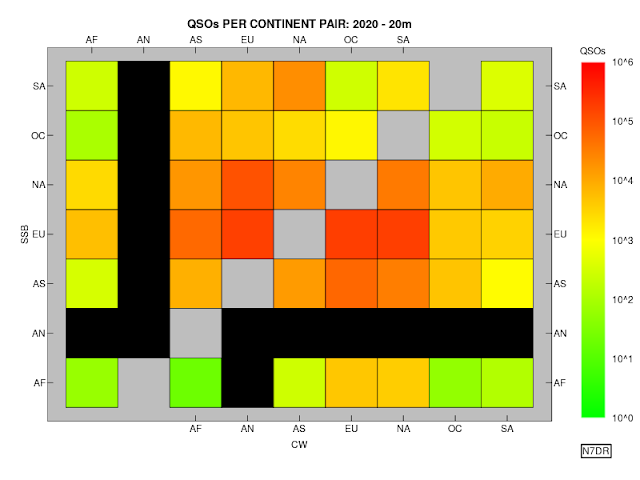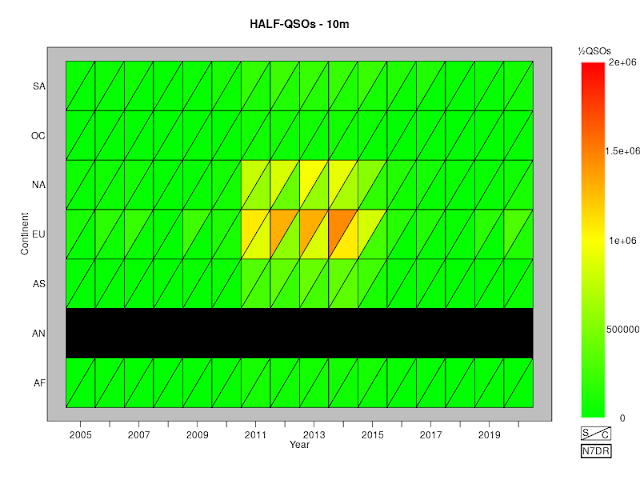In addition to zone-based analyses, we can perform similar analyses based on continent rather than zone using the various public CQ WW logs (cq-ww-2005--2020-augmented.xz; see here for details of the augmented format) for the period from 2005 to 2020.
Continent Pairs
We start by looking at the number of QSOs for pairs of continents from the contests for 2020.
The procedure is simple. We consider only QSOs that meet the following criteria:
- marked as "two-way" QSOs (i.e., both parties submitted a log containing the QSO);
- no callsign or zone is bust by either party.
A counter is maintained for every possible pair of continents and the pertinent counter is incremented
once for each distinct QSO between stations in those continents.
Separate
figures are provided below for each band, led by a figure integrating
QSOs on all bands. The figures are constructed in such a way as to show
the results for both the SSB and CW contests on a single figure. (Any
pair of continents with no QSOs that meet the above criteria appears in
black on the
figures.)
Continents and Distance
Below is a series of figures showing the distribution of distance for QSOs as a
function of continent.
Each
plot shows a colour-coded distribution of the distance of QSOs for each
continent, with the data for SSB appearing above the data for CW within
each continent.
For every half-QSO in a given continent, the distance
of the QSO is calculated; in this way, the total number of half-QSOs in
bins of width 500 km is accumulated. Once all the QSOs for a particular mode have been binned in this manner, the distribution for each
continent
is normalised to total 100% and the result coded by colour and plotted.
The mean distance for each continent and mode is denoted by a small
white
rectangle added to the underlying distance distribution. The 99%
confidence range of the value of mean is marked by a small blue
rectangle (typically entirely subsumed by the white rectangle). The
median is marked with a vertical brown rectangle.
As
usual, only QSOs for which logs have been provided by both parties, and
which show no bust of either callsign or zone number are included. Bins
coloured black are those for which no QSOs are present at the relevant
distance.
The
resulting plots are reproduced below.
Half-QSOs Per Continent, 2005 to 2020
A simple way to display the activity in the CQ WW contests
is to count the number of half-QSOs in each continent (a single QSO
contains two half-QSOs, so a single QSO may contain two different
continents or the same continent twice). We count half QSOs, making sure
to include each valid QSO
only once (that is, if the same QSO appears in two submitted logs, it is
counted only once).
If we do this for the entire contest without taking the individual bands into account, we obtain this figure:
The plot shows data for both SSB and CW contests over the period from
2005 to 2020. I include only QSOs for which both parties submitted a log
and neither
party bust either the zone or the call of the other party. The black
triangles represent contests in which no half-QSOs were made from (or
to) a particular continent. We can, of course, generate equivalent plots
on a band-by-band basis:
As in prior years, the activity from EU so overwhelms these figures that
in order to get a feel for the activity elsewhere, we need to move to a
logarithmic scale:
Intra-Continental QSOs
We can also easily look at the percentage of QSOs that are between two
stations on the same continent, and in particular between two EU
stations:
So, for example, in CQ WW CW in 2020, somewhat more than 30% of all QSOs were
within the same continent; about 27% of QSOs -- more than a quarter -- were
between two European stations. Yet, judging from the name, which is "CQ
World Wide DX Contest", this is supposed to be a world-wide DX contest,
not a European QSO party.
Flogging a dead horse, on 160m nearly 70% of QSOs in this "world wide DX" contest were between two European entrants, even in the more DX-friendly mode. On SSB, 90%(!) of similar QSOs were between two European entrants.



































No comments:
Post a Comment
Note: Only a member of this blog may post a comment.